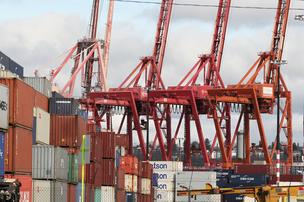West Coast port cargo diverted east during slowdown likely to remain there
Anthony Bolante
To avoid cargo sitting on the docks, some shippers diverted to the East Coast ports. East Coast ports saw more growth in the fourth quarter of 2014 than any of the previous 11 quarters.
- Sarah Aitchison
- Staff Writer-Puget Sound Business Journal
- Email | Twitter
While shippers and businesses using West Coast ports struggled during months of slowdowns, East Coast ports picked up diverted cargo. The bad news for the West Coast is that it's likely some of that cargo will remain in the east.
The biggest East Coast ports had 10.2 percent more growth than the biggest West Coast ports in the fourth quarter of 2014, compared to a 1.6 percent difference from the year before.
In the quarter before the slowdowns began, West Coast ports had more growth than East Coast ports.
That traffic directly corresponds with slowdowns, according to Fitch Ratings, an agency that determines credit ratings at United States ports. In the fourth quarter of 2014, East Coast ports had more growth than any of the 11 previous quarters.
Some of that diverted cargo will never come back.
"With each labor event, some diverted cargo has not returned, and this seems to be the case for some West Coast ports coming out of this most recent contract negotiation," according to Fitch.
Along with the East Coast, shippers also diverted cargo to Canada and Mexico. The number of vessels and containers traveling through the Suez Canal and Panama Canal also increased, "to avoid costly delays moving goods through the West Coast," according to Fitch.
The Port of Seattle is mostly just a pit stop as goods make their way around the country.
While the Port of Seattle doesn't track exactly how much cargo shipped through the harbor moves outside the state, most of it is shipped elsewhere, said spokesman Perry Cooper.
When cargo isn't staying in Washington state, shippers have less incentive to use Washington state ports when others are more reliable.
"If the shippers are concerned [slowdowns around negotiations] will keep happening and they diverted their cargo and are happy with that service," Griffith said, "perhaps they will keep it there."
In the midst of this year's slowdowns, shipping company Hanjin announced it would no longer dock and unload at the Port of Portland. Hanjin accounted for 78 percent of container traffic volume at Terminal 6, one of Portland's four terminals.
That pattern isn't new.
Griffith said after the 2002 slowdowns one major carrier moved from the ports of Los Angeles and Long Beach to San Diego.
"They were treated very well, and they've stayed there ever since," she said.
West Coast ports operated at an average of 50 percent normal efficiency during contract negotiations between the dockworker's union and the association that represents terminal operators. After nearly nine months of negotiations and help from two federal officials, the two parties reached a tentative agreement last week.
It could take up to a few months for the union to ratify the contract. Port operations are back to normal and it will take no more than three weeks to clear backlog at the ports of Seattle and Tacoma.


No comments:
Post a Comment